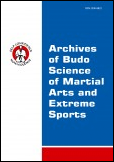2016, Volume 12, Issue 1
An isokinetic profile in senior female and male karate athletes
Aleksandar Kotrljanovic1, Dragan Atanasov2, Dragoljub Veljovic1, Patrik Drid1
1Faculty of Sport and Physical Education, University of Novi Sad, Novi Sad, Serbia
2Faculty of Sport, University Union – Nikola Tesla, Belgrade, Serbia
Author for correspondence: Aleksandar Kotrljanovic; Faculty of Sport and Physical Education, University of Novi Sad, Novi Sad, Serbia; email: kotrljanovic[at]gmail.com
Full text
Abstract
Background & Study Aim: Using isokinetic testing in order to detect antagonist/agonist strength ratios we can get reliable and reproducible measurements which can be used for injury prevention. Knowledge of these phenomena is essential in order to detect possible differences and similarities, as well as compare results between genders of karate athletes. The aim of this study is isokinetic profile in elite female and male karate athletes.
Material and Methods: The testing group was comprised of 9 male and 9 female karate athletes and they were all members of National karate team of Serbia. Each participant completed the testing in single session (~1.5 h), and each group completed the testing over the course of 3 days, with testing occurring at the same time of the day. We investigated conventional concentric strength ratios and contralateral differences for both shoulders and knees at both 60°/s and 180°/s testing speeds. For the results analysis, the Statistical Package for Social Science (SPSS), version 20.0 was used.
Results: Significant differences were observed in knee and shoulder strength between female and male karate athletes. Both female and male karate athletes showed recommended results for conventional concentric H:Q strength ratio, as well as in contralateral concentric H and Q strength ratio. Also, both athletes showed higher conventional concentric ER:IR strength ratio than recommended.
Conclusions: There was a number of individuals with imbalances greater than recommended, but karate group as a whole was at a low risk of musculoskeletal injury and it can be concluded that karate stimulate body symmetrically during training over the years.
Key words: cross-sectional studies, humans, knee, knee injuries, martial arts, muscle strength, physical fitness, shoulder, torque





